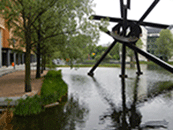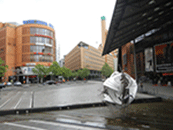Germany and Copenhagen Stormwater Projects Serve as Models for U.S.
In the spring of 2013, UMASS Professor Jack Ahern led a group of students to Berlin and Copenhagen to explore the form and function of some spectacular green infrastructure systems embedded within heavily used public squares and pedestrian malls. The following article is written by John Doherty, a UMASS undergraduate who traveled with Jack to explore these exemplary spaces.
Transferring Innovation from Europe to the U.S.
Addressing rain water is not something most people recognize as an important issue. For planners and landscape designers, however, rain water solutions are pivotal in the creation or renovation of a space. There is enormous potential in the world of stormwater management to create projects that not only serve their function as infrastructure but generate a number of other beautiful and sustainable benefits. Europe is a leader in sustainability in terms of projects and legislation, with a number of places that have adopted innovative stormwater management practices. Rain gardens and swales have begun popping up across the U.S. as well. This entry highlights some of the landmark developments that I had the fortune of visiting, and that serve as examples for the Pioneer Valley.
Potsdamer Platz, Berlin, Germany
Berlin is an extremely unique city in almost every way possible, whether considering its history, people, or its development over the years. This is partly due to the innovation and groundbreaking work found in the city. Potsdamer Platz is a popular square in Berlin that is one example. Formerly a hub of the city, the Berlin wall cut right through Potsdamer during the division of Germany. Once the wall came down, this once great square was left barren and somewhat taboo. The city decided to bring in large companies and investors to revitalize what used to be the city’s center. Potsdamer Platz is now home to a number of impressive modern buildings and what could be considered one of the best stormwater management projects in the world.
 |
 |
 |
Stormwater pool |
Stormwater pool and vegetation |
Potsdamer Platz |
Designed by the firm Atelier Dreiseitl, the stormwater system in Potsdamer utilizes green infrastructure to address water on the site. It all starts up top on the roofs. Several of the roofs in the square are “green roofs,” with vegetation that collects and uses a fair amount of water on its own. Roofs that are not “green” still collect the rain water and run it through grey water systems in the building. So when the toilets are flushed or if the fire sprinklers go off, harvested rain water does the job! In the case of a large storm, excess water runs off the buildings into a number of reflecting ponds and pools incorporated all over the square. These ponds and pools hold excess water, but the majority is kept in five large cisterns that are located below the square underground. The cisterns are used to keep the pools full in times of drought and hold water for the grey water systems. This project underscores form and function in our built environment. This modern city square with breathtaking architecture, beautiful water features, and a wonderfully designed water system provides an important example to developers .
Copenhagen, Denmark
Europe is with a leader in sustainability, and examples can be seen all over and not just directly in projects like Potsdamer but also in laws and legislation. For example in Copenhagen, Denmark, officials have recently passed a law that green roofs are required in all new developments where the slope is less than or equal to 30 degrees. Green roofs provide a great way to mitigate for storm water runoff right where it falls, as well as providing a very aesthetic way to bring nature into the built environment.
 |
 |
Green roof, rain garden and porous pavement |
Green roof |
These examples from Europe demonstrate some creative solutions for turning rain water into an urban resource. Stay tuned for many more creative solutions from right here in the Pioneer Valley.

